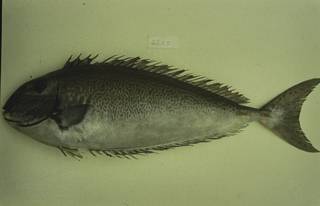
| Intro | | Search taxa | | Browse taxa | | Distributions | | Terminology | | References | | Statistics | | Online sources | | Tutorial | | Log in |
WoRMS taxon detailsAcanthuridae Bonaparte, 1835
Nasinae Fowler & Bean, 1929 · unaccepted
Prionurinae Smith, 1966 · unaccepted
marine, brackish,
Not documented
Description Circumtropical, especially around coral reefs; five species in the Atlantic, the remaining in the Pacific and Indian...
Description Circumtropical, especially around coral reefs; five species in the Atlantic, the remaining in the Pacific and Indian oceans. All have a deep compressed body with the eye high on the head and a long preorbital bone. Single unnotched dorsal fin with 4-9 spines and 19-33 rays; anal fin with 2 (only Naso) or 3 spines and 18-28 rays; pelvic fins with 1 spine and 3 (Naso and Paracanthurus) or 5 rays. Very small ctenoid scales. A small terminal mouth with a single row of close-set teeth. Most surgeon fishes graze on benthic algae and have a long intestine; some feed mainly on zooplankton or detritus. Surgeon fishes are able to slash other fishes with their sharp caudal spines by a rapid side sweep of the tail. Many species have bright colors and are popular aquarium fishes. [details]
Froese, R. and D. Pauly. Editors. (2024). FishBase. Acanthuridae Bonaparte, 1835. Accessed through: World Register of Marine Species at: https://www.marinespecies.org/aphia.php?p=taxdetails&id=125515 on 2024-11-07
Date action by
taxonomy source
Van Der Laan, R.; Eschmeyer, W. N.; Fricke, R. (2014). Family-group names of Recent fishes. <em>Zootaxa.</em> 3882(1): 1-230., available online at https://doi.org/10.11646/zootaxa.3882.1.1 [details] Available for editors
context source (PeRMS) Chirichigno, N.; Cornejo, M. (2001). Catálogo comentado de los peces marinos del Perú. <em>2ª ed. Instituto del Mar de Perú. Publicación Especial. Callao.</em> 314 p. [details] basis of record van der Land, J.; Costello, M.J.; Zavodnik, D.; Santos, R.S.; Porteiro, F.M.; Bailly, N.; Eschmeyer, W.N.; Froese, R. (2001). Pisces, <B><I>in</I></B>: Costello, M.J. <i>et al.</i> (Ed.) (2001). <i>European register of marine species: a check-list of the marine species in Europe and a bibliography of guides to their identification. Collection Patrimoines Naturels,</i> 50: pp. 357-374 (look up in IMIS) [details] additional source Fricke, R., Eschmeyer, W. N. & Van der Laan, R. (eds). (2024). ECoF. Eschmeyer's Catalog of Fishes: Genera, Species, References. <em>California Academy of Sciences. San Francisco.</em> Electronic version accessed dd mmm 2024., available online at http://researcharchive.calacademy.org/research/Ichthyology/catalog/fishcatmain.asp [details]  Present Present  Inaccurate Inaccurate  Introduced: alien Introduced: alien  Containing type locality Containing type locality
Unreviewed
Description Circumtropical, especially around coral reefs; five species in the Atlantic, the remaining in the Pacific and Indian oceans. All have a deep compressed body with the eye high on the head and a long preorbital bone. Single unnotched dorsal fin with 4-9 spines and 19-33 rays; anal fin with 2 (only Naso) or 3 spines and 18-28 rays; pelvic fins with 1 spine and 3 (Naso and Paracanthurus) or 5 rays. Very small ctenoid scales. A small terminal mouth with a single row of close-set teeth. Most surgeon fishes graze on benthic algae and have a long intestine; some feed mainly on zooplankton or detritus. Surgeon fishes are able to slash other fishes with their sharp caudal spines by a rapid side sweep of the tail. Many species have bright colors and are popular aquarium fishes. [details]
To Biological Information System for Marine Life (BISMaL)
To European Nucleotide Archive, ENA (Acanthuridae) To European Nucleotide Archive, ENA (Nasinae) (from synonym Nasinae Fowler & Bean, 1929) To Genbank To Genbank (from synonym Nasinae Fowler & Bean, 1929) To NMNH Extant Collection (Acanthuridae FIN026096 Slide 35 mm) To ITIS |

